
The lowland nyala or simply nyala is a spiral-horned artiodactyl antelope native to Southern Africa. The species is part of the family Bovidae and the genus Tragelaphus. It was first described in 1849 by George French Angas and exhibits the highest sexual dimorphism among the spiral-horned antelopes. It is not to be confused with the endangered mountain nyala living in the Bale region of Ethiopia.
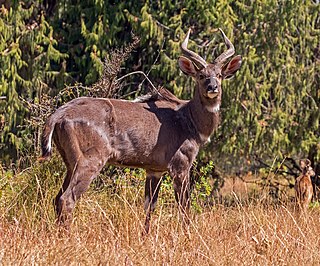
The mountain nyala or balbok, is a large antelope found in high altitude woodlands in a small part of central Ethiopia. It is a monotypic species first described by English naturalist Richard Lydekker in 1910. The males are typically 120–135 cm (47–53 in) tall while females stand 90–100 cm (35–39 in) at the shoulder. Males weigh 180–300 kg (400–660 lb) and females weigh 150–200 kg (330–440 lb). The coat is grey to brown, marked with two to five poorly defined white strips extending from the back to the underside, and a row of six to ten white spots. White markings are present on the face, throat and legs as well. Males have a short dark erect crest, about 10 cm (3.9 in) high, running along the middle of the back. Only males possess horns.

The Ethiopian wolf, also called the red jackal, the Simien jackal or Simien fox, is a canine native to the Ethiopian Highlands. In southeastern Ethiopia, it is also known as the horse jackal. It is similar to the coyote in size and build, and is distinguished by its long and narrow skull, and its red and white fur. Unlike most large canids, which are widespread, generalist feeders, the Ethiopian wolf is a highly specialised feeder of Afroalpine rodents with very specific habitat requirements. It is one of the world's rarest canids, and Africa's most endangered carnivore.

Gir National Park and Wildlife Sanctuary, also known as Sasan Gir, is a forest, national park, and wildlife sanctuary near Talala Gir in Gujarat, India. It is located 43 km (27 mi) north-east of Somnath, 65 km (40 mi) south-east of Junagadh and 60 km (37 mi) south-west of Amreli. It was established in 1965 in the erstwhile Nawab of Junagarh's private hunting area, with a total area of 1,410.30 km2 (544.52 sq mi), of which 258.71 km2 (99.89 sq mi) is fully protected as a national park and 1,151.59 km2 (444.63 sq mi) as wildlife sanctuary. It is part of the Khathiar-Gir dry deciduous forests ecoregion.
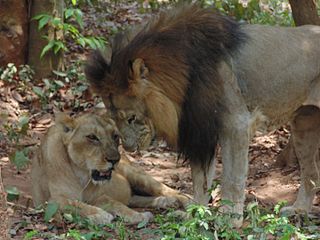
Panthera leo leo is a lion subspecies present in West Africa, northern Central Africa and India. In West and Central Africa it is restricted to fragmented and isolated populations with a declining trajectory. It has been referred to as the northern lion.

The Cardamom Mountains, or the Krâvanh Mountains, is a mountain range in the southwest part of Cambodia and Eastern Thailand. The majority of the range is within Cambodia.

Hemis National Park is a high-elevation national park in Hemis in Leh district of Ladakh, India. It approx. 50 km from Leh, the capital of Ladakh. Globally famous for its snow leopards, it is believed to have the highest density of them in any protected area in the world. It is the only national park in India that is north of the Himalayas, the largest notified protected area in India and is the second largest contiguous protected area, after the Nanda Devi Biosphere Reserve and surrounding protected areas. The park is home to a number of species of endangered mammals, including the snow leopard. Hemis National Park is India's protected area inside the Palearctic realm, outside the Changthang Wildlife Sanctuary northeast of Hemis, and the proposed Tso Lhamo Cold Desert Conservation Area in North Sikkim.
San Giovanni Teatino is a comune and town in the Province of Chieti in the Abruzzo region of Italy. Until 1894 this comune was known as Forcabobolina. Situated on a hill overlooking the valley of the river Pescara (Aterno-Pescara), in recent years the place has undergone an industrial development, especially in the area of Sambuceto. Abruzzo Airport is also located in a portion of the municipal territory, close to the border with Pescara. In fact, the municipality is virtually divided into two, San Giovanni Teatino (Alto), which is the historic village on the hill, and the aforementioned Sambuceto, an ever-growing urban settlement, home to a large shopping area and an important industrialized area.<>
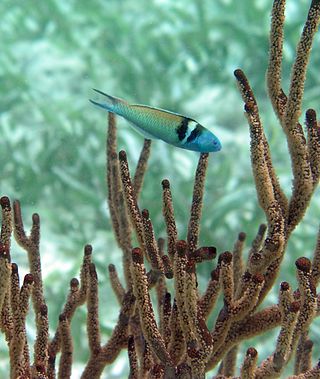
Since declaring independence in 1981, Belize has enacted many environmental protection laws aimed at the preservation of the country's natural and cultural heritage, as well as its wealth of natural resources. These acts have established a number of different types of protected areas, with each category having its own set of regulations dictating public access, resource extraction, land use and ownership.
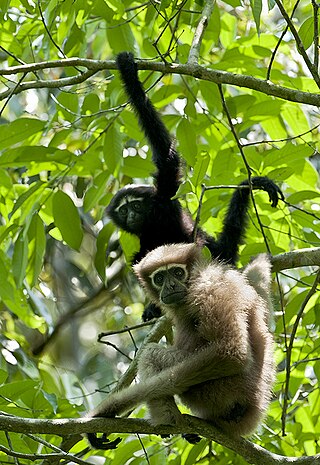
The Hollongapar Gibbon Sanctuary, formerly known as the Gibbon Wildlife Sanctuary or Hollongapar Reserved Forest, is an isolated protected area of evergreen forest located in Assam, India. The sanctuary was officially constituted and renamed in 1997. Set aside initially in 1881, its forests used to extend to the foothills of the Patkai mountain range.

Kundudo is a flat-top mountain in the Misraq Hararghe Zone of the Oromia region of Ethiopia. Part of the 13-kilometre (8 mi) range that bears its name, its summit lies east of the walled city of Harar, with a height of nearly 3,000 metres (9,800 ft).

The Tonkin snub-nosed monkey or Dollman's snub-nosed monkey is a slender-bodied arboreal Old World monkey, endemic to northern Vietnam. It has black and white fur, a pink nose and lips, and blue patches around the eyes. It is found at elevations from 200 to 1,200 m on fragmentary patches of forest on craggy limestone areas. First described in 1912, the monkey was rediscovered in 1989 but is exceedingly rare. Out of the five snub-nosed monkey species in the world, the Tonkin snub-nosed monkey is the rarest. In 2008, fewer than 250 individuals were thought to exist, and the species was the subject of intense conservation effort. The main threats faced by these monkeys are habitat loss and hunting, and the International Union for Conservation of Nature has rated the species as "critically endangered".
The nyala and the mountain nyala are African antelopes. The term Nyala may also refer to:

Kutch Bustard Sanctuary or Kachchh Great Indian Bustard Sanctuary, also known as Lala–Parjan Sanctuary, is located near Jakhau village in Taluka Abdasa, Gujarat, India. This sanctuary is one of the two great Indian bustard sanctuaries in Gujarat; the other one is in Jamnagar. It was declared as a sanctuary in July 1992, specifically for the conservation of the great Indian bustard, the heaviest flying bird belonging to the avian family of Otididae. However, the sanctuary presently legally covers a protected area of about 2 square kilometres (0.77 sq mi) of area (202.86 hectares of fenced land only and is the smallest sanctuary in the country. Several suggestions have been made to vastly increase the size of this sanctuary as it is a breeding ground of the endangered great Indian bustard. The reason is that its ecological zone is much larger on account of anthropogenic and cattle population pressure that are considered as a ‘biotic threat’ to this omnivorous species.
The Afi Mountain Wildlife Sanctuary in Cross River State in southern Nigeria covers 104 km2 (40 sq mi). The wildlife sanctuary was founded in 2000 to provide refuge for endangered animal species, including the Cross River gorilla, the Nigeria-Cameroon chimpanzee, the drill and the gray-necked rockfowl.
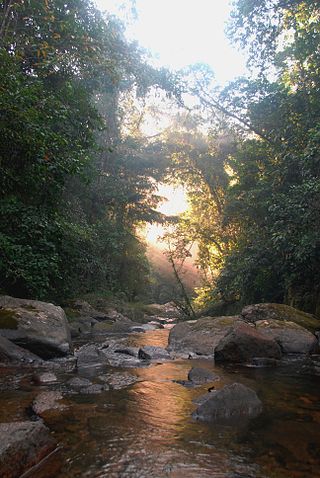
Bladen Nature Reserve in Belize is a landscape of caves, sinkholes, streams and rivers, old growth rainforest and an abundance of highly diverse flora and fauna which includes a great deal of rare and endemic species.

The Indochinese leopard is a leopard subspecies native to mainland Southeast Asia and southern China. In Indochina, leopards are rare outside protected areas and threatened by habitat loss due to deforestation as well as poaching for the illegal wildlife trade. In 2016, the population was previously thought to comprise 973–2,503 mature individuals, with only 409–1,051 breeding adults. The historical range had decreased by more than 90%. However, as of 2019, it is estimated that there are 77-766 mature Indochinese leopards and that their numbers are decreasing.

The Imatong Mountains are mainly located in Eastern Equatoria in southeastern South Sudan, and extend into the Northern Region of Uganda. Mount Kinyeti is the highest mountain of the range at 3,187 metres (10,456 ft), and the highest point of South Sudan.
Arsi Mountains National Park is a national park in Arsi Zone of Oromia Region in Ethiopia. It protects a portion of the Ethiopian Highlands, and includes montane forests, subalpine heath, and alpine grasslands and shrublands. The park was designated in 2011, and covers an area of 10876 km2.















